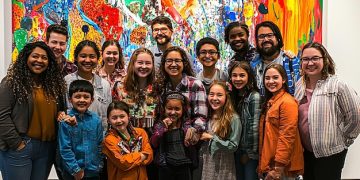Cultural Appropriation Debates in the US: A Deep Dive

Anúncios
The current debates surrounding cultural appropriation in the US revolve around the ethical implications of adopting elements from minority cultures by members of the dominant culture, often without understanding or respect, raising questions of power dynamics, historical context, and potential harm.
Navigating the complex landscape of cultural exchange, one inevitably encounters the contentious issue of cultural appropriation; what are the current debates surrounding cultural appropriation in the US?
Anúncios
Understanding Cultural Appropriation: A Definition
Cultural appropriation, at its core, involves taking elements from a minority culture by members of a dominant culture. This seemingly simple definition, however, masks a complex web of ethical and social implications that fuel ongoing debates. These debates often center on the power dynamics involved, the historical context of the cultures in question, and the potential for harm when cultural elements are taken out of their original context or trivialized.
Defining Cultural Appropriation
The debate over cultural appropriation is nuanced, with varied definitions and opinions influencing the discussion. For some, it’s strictly about power dynamics, where a dominant group exploits a marginalized group’s culture. For others, it’s more about the lack of understanding or respect shown towards the original culture.
Anúncios
Distinguishing Cultural Exchange from Appropriation
Understanding the difference between cultural exchange and appropriation is crucial. Cultural exchange involves a reciprocal sharing of ideas and traditions, often with mutual respect and understanding. Appropriation, on the other hand, often lacks this reciprocity, potentially leading to the commodification or misrepresentation of cultural elements.

Ultimately, the discussions around defining cultural appropriation highlight the subjective nature of the concept and the necessity for careful consideration of context and intent.
Historical Context: The Roots of Appropriation
The history of cultural appropriation in the US is deeply intertwined with a legacy of colonialism, slavery, and systemic oppression. Understanding this historical backdrop is essential for grasping the present-day discussions. The extraction of cultural elements from marginalized communities has deep roots, often occurring alongside or as a direct result of social and political exploitation.
Colonialism and Cultural Extraction
Throughout history, colonizers have often adopted or adapted cultural practices and artifacts from the colonized, frequently without giving credit or understanding the original significance. This extraction of cultural elements was often used to justify the superiority of the colonizing culture and to further subjugate the colonized people.
Slavery and African American Culture
The history of slavery in the US is marked by the appropriation of African culture, often through minstrel shows and other forms of entertainment that mocked and misrepresented African American traditions. These caricatures not only perpetuated harmful stereotypes but also stripped African American culture of its dignity and complexity.
- Understanding the role of historical power imbalances.
- Recognizing the impact of past injustices on present-day cultural dynamics.
- Examining instances where cultural appropriation was a direct tool of oppression.
In essence, the historical context reveals that cultural appropriation is not a modern phenomenon but is deeply embedded in historical power dynamics, where marginalized groups have had their cultural heritage exploited and misrepresented.
Power Dynamics: Who Benefits and Who is Harmed?
A central tenet of the **what are the current debates surrounding cultural appropriation in the US?** lies in the examination of power dynamics. It’s about understanding who is benefiting from the use of cultural elements and who is potentially harmed. Often, cultural appropriation occurs when a dominant group takes from a marginalized group, reinforcing existing inequalities and perpetuating stereotypes.
Exploitation vs. Appreciation
One of the critical debates is whether an act is exploitative or appreciative. When elements of a minority culture are adopted without understanding or respect, it can be seen as exploitative. Appreciation, on the other hand, involves a genuine effort to understand and honor the original culture.
Amplification vs. Erasure
Cultural appropriation can sometimes lead to the erasure of the original creators or practitioners of a cultural tradition. Instead of amplifying the voices and contributions of the original culture, the appropriator may receive undue recognition or profit, further marginalizing the source community.

The crux of the matter is that the discussion is highly polarized, with many people on both sides of the issue holding diametrically opposed views. These debates continue because marginalized communities feel that their heritage is being unfairly exploited.
Economic Dimensions: Commodification and Profit
The economic dimensions of cultural appropriation are increasingly under scrutiny, particularly concerning the commodification of cultural elements for profit. This involves turning cultural practices, symbols, or artifacts into marketable products, often without the consent or benefit of the originating community. The debates focus on whether this commodification respects or exploits the culture in question.
Profiting from Cultural Heritage
When businesses or individuals profit from cultural heritage without involving or compensating the originating community, it raises ethical questions. This can range from fashion designers using traditional patterns without acknowledging the cultural significance, to companies marketing cultural foods without sharing the economic benefits with the communities that created them.
Intellectual Property and Cultural Artifacts
Protecting cultural heritage through intellectual property laws poses unique challenges. While copyright and trademark laws can offer some protection, they often fall short of addressing the specific needs of indigenous and traditional communities. Additionally, debates arise over who has the right to own or control cultural artifacts and knowledge.
- Examining the role of copyright in protecting cultural designs.
- Considering the ethical responsibilities of businesses using cultural elements.
- Highlighting initiatives that support indigenous entrepreneurship.
The economic impact is keenly felt within minority cultures, who may see their traditions turned into commodities, while profits accrue to those outside their community.
Artistic Expression vs. Cultural Theft
In artistic contexts, the lines between inspiration and appropriation can become blurred. Artists often draw inspiration from various cultures, but when does this inspiration cross the line into cultural theft? The debates surrounding this issue involve discussions of intent, respect, and transformation.
Inspiration vs. Replication
Determining whether an artist is genuinely inspired by a culture or simply replicating its elements without understanding or appreciation is crucial. Often, it comes down to the artist’s intent and the level of respect they show towards the original culture.
Transformation and Recontextualization
Many artists argue that their work transforms and recontextualizes cultural elements, creating something new and unique. However, this argument is not always accepted, especially when the original culture feels that the transformation is disrespectful or trivializes their traditions.
Ultimately, society is challenged to determine what artistic expression truly is versus the theft of tradition, especially in the digital age, which has brought new attention to the debate.
Social Justice and Activism: Demanding Accountability
Social justice movements and activism play a significant role in shaping the discussions around cultural appropriation. Activists demand accountability from individuals, businesses, and institutions engaging in cultural appropriation, advocating for respect, representation, and redress.
Raising Awareness through Social Media
Social media has become a powerful tool for raising awareness about cultural appropriation. Activists use social media platforms to call out instances of appropriation, educate the public, and organize campaigns for change.
Promoting Cultural Sensitivity and Education
Many organizations and activists focus on promoting cultural sensitivity and education to prevent cultural appropriation. These initiatives often involve workshops, educational materials, and public awareness campaigns that highlight the importance of understanding and respecting diverse cultural traditions.
- Highlighting successful campaigns against cultural appropriation.
- Examining the role of education in preventing appropriation.
- Discussing the challenges of achieving cultural sensitivity.
Social justice movements and the accompanying activism ensures that cultural appropriation is not seen as harmless, but viewed as an injustice that demands attention.
| Key Point | Brief Description |
|---|---|
| 🤔 Definition of Appropriation | Taking elements from a minority culture by a dominant one. |
| 🏛️ Historical Context | Roots in colonialism, slavery, and systemic oppression. |
| ⚖️ Power Dynamics | Benefits to dominant groups, harm to marginalized groups. |
| 💰 Economic Dimensions | Commodification of cultural elements for profit. |
Frequently Asked Questions
▼
Cultural appropriation involves taking elements from a minority culture without understanding or respect, while cultural exchange is a reciprocal sharing of ideas and traditions with mutual understanding.
▼
Historical context is crucial because cultural appropriation often has roots in colonialism, slavery, and systemic oppression, impacting present-day power dynamics and sensitivities.
▼
Economic issues include profiting from cultural heritage without involving or compensating the originating community, often seen in industries like fashion and food.
▼
Social media serves as a powerful tool for raising awareness, calling out instances of appropriation, educating the public, and organizing campaigns for change.
▼
To avoid cultural appropriation, one should prioritize education, respect, and understanding of diverse cultures, and involve the originating community in any adaptation or use of their cultural elements.
Conclusion
In conclusion, the debates surrounding cultural appropriation in the US are complex and multi-faceted, involving historical context, power dynamics, economic dimensions, and social justice issues. Addressing these debates requires a commitment to education, respect, and accountability, fostering a more equitable and inclusive society.





